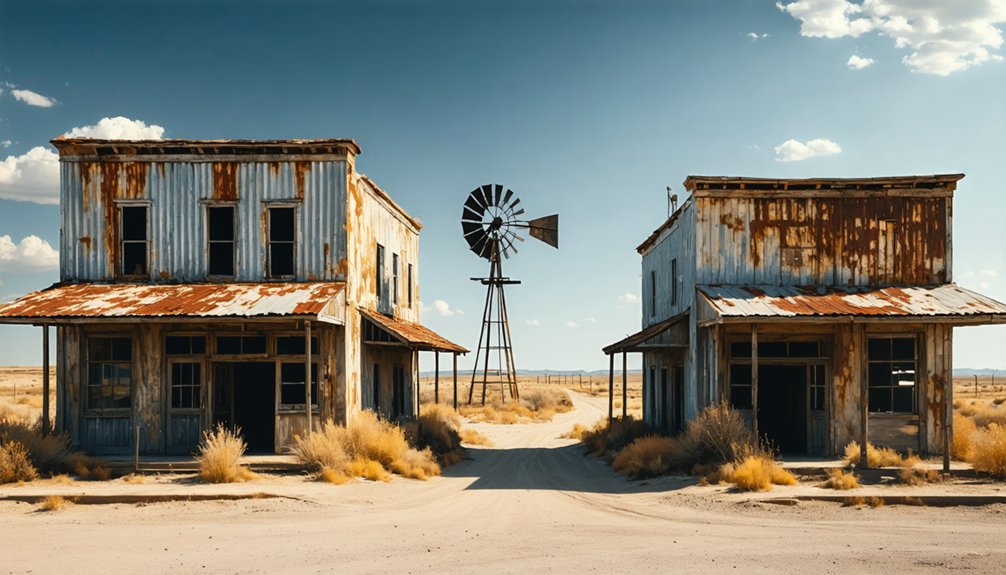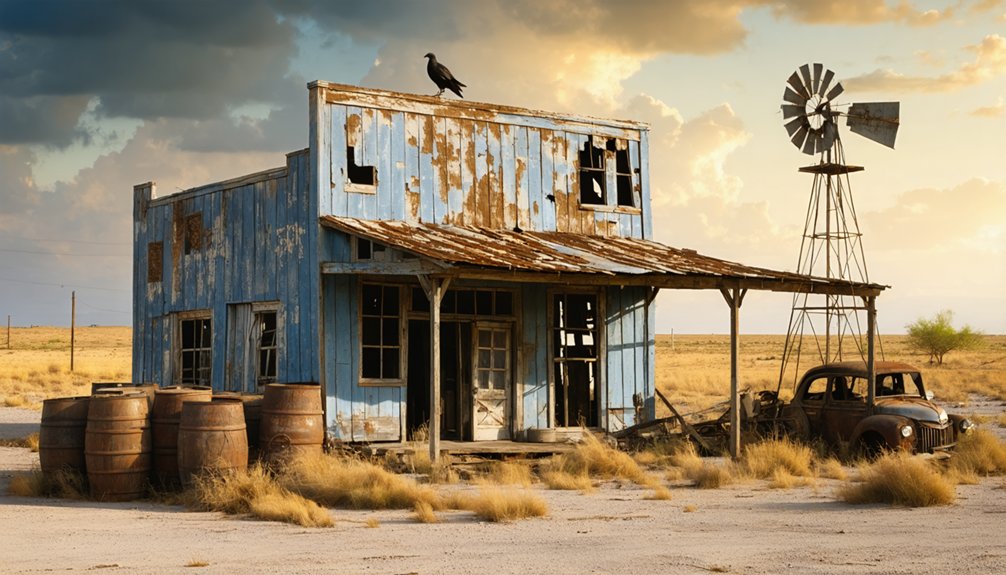You’ll find Verbena, a ghost town in Garza County, Texas, perched atop the Llano Estacado mesa. This early 1900s ranching settlement grew around church gatherings and gained official recognition with a post office in 1901. The semi-arid plains and limited water sources challenged settlers, while transportation shifts and economic decline led to its abandonment. Today, only scattered foundation remnants on private property mark where this once-vibrant ranching community stood, each crumbling stone telling a deeper story.
Key Takeaways
- Verbena began as a small ranch settlement in early 1900s Garza County, Texas, centered around church meetings and agricultural activities.
- The community’s establishment was marked by the opening of a post office in 1901, serving as a vital link to outside world.
- Located on the Llano Estacado mesa, the town faced challenges from semi-arid conditions and limited water resources.
- Economic decline occurred due to transportation network changes, leading to business closures and population exodus.
- Today, Verbena exists as an inaccessible ghost town on private property, with only sparse foundations remaining as evidence.
Origins and Settlement History
Unlike many Texas ghost towns that emerged around railroads or mining operations, Verbena began as a humble gathering of ranch settlers in the early 1900s.
You’ll find that the settlement patterns here were distinctly different from industrial boom towns – the community formed organically around church meetings rather than economic ventures.
The community dynamics were shaped by the needs of local ranchers and their families who’d gather regularly for religious services.
These gatherings became the backbone of social life, creating strong bonds among the dispersed rural population.
The area gained its first official recognition when the post office opened in J.B. Cotton’s home in 1901.
You won’t find records of major immigrant influxes or industrial development here, unlike towns such as Mingus where there was a clear divide between American-owned and immigrant-owned businesses.
Instead, Verbena’s growth remained slow and steady, tied closely to the agricultural rhythm of ranch life and the spiritual fellowship that brought these frontier families together.
Geographic Features and Location
Nestled in the vast expanse of Garza County, Texas, Verbena sits atop the distinctive Llano Estacado mesa, where semi-arid plains stretch toward the horizon.
You’ll find yourself surrounded by short prairie grasses and sparse vegetation, a landscape characteristic of West Texas’s rugged beauty. Similar to Old Bluffton’s remains, occasional droughts reveal hidden features of the land, highlighting the harsh environment. The town’s remote accessibility reflects its historical position along early postal routes, though you won’t find major highways or rail lines nearby today.
The sandy loam soil and caliche beneath your feet tell the story of limited farming potential, while the open terrain leaves you exposed to the region’s dramatic weather patterns. Much like Medicine Mound’s dolomite hills, the area’s natural elevation provides stunning vistas of the surrounding plains.
Without significant water sources close by, you’re reminded of the challenging conditions early settlers faced as they carved out their existence in this untamed corner of the southern High Plains.
Life in Early Verbeba
Early life in Verbeba centered on a close-knit community of ranching families who carved out their existence in the harsh Llano Estacado landscape.
You’d find community bonds forged through church meetings and social gatherings at the local post office, which operated from a settler’s home. Your daily routine would’ve revolved around demanding ranch work, tending cattle, and managing crops in the unforgiving Texas climate. The residents faced challenges similar to Thurber’s miners who received their wages through a restrictive once-a-month paycheck.
Without modern conveniences, you’d rely on self-sufficiency and neighborly support. Social gatherings served as essential connections, where you’d share news, trade goods, and strengthen ties through religious services. Like the nearby town of Plemons, Verbeba’s residents relied on safe river crossings to maintain vital connections with neighboring communities.
Mail delivery provided your primary link to the outside world, while transportation meant long rides by horse or wagon. Despite the isolation and primitive conditions, you’d find strength in the shared experience of frontier living.
Economic Rise and Fall
You’ll find that Verbeba’s early economic importance centered on agricultural trade and ranching operations, which supported a network of local merchants and service providers.
The town’s fortune shifted as mining ventures attempted to diversify the economy, though these efforts ultimately proved unsustainable due to resource limitations and market fluctuations. Similar to Post City’s challenges with water supply issues, the town struggled to maintain consistent resources for its industrial operations. Many miners faced hardship when silver ore deposits became inaccessible in the 1940s.
The decline of regional transportation networks and exodus of working families accelerated Verbeba’s economic downturn, leading to the closure of essential businesses and services.
Early Trade and Commerce
The economic story of Verbena began modestly in the early 1900s, centered around informal trade networks established by local ranching families.
You’d find the earliest local commerce taking place during church gatherings, where settlers exchanged essential goods and services. The establishment of a post office in J.B.’s home marked the first step toward formalized trade infrastructure.
Ranch supplies and basic necessities flowed through Verbena from larger hubs like Plemons, though the town’s trade remained small-scale without railroad access. Much like Belle Plain College’s closure, Verbena’s growth was stunted by persistent drought conditions.
You’ll notice the pattern was typical of frontier settlements – scattered general stores and essential services emerged to serve passing ranchers and travelers.
While regional cattle drives brought periodic economic boosts, Verbena’s commercial development stayed limited, primarily focused on serving local ranching operations.
Mining and Agriculture Impact
While Verbena never experienced the explosive growth of neighboring Thurber’s coal industry, mining activities still shaped the town’s economic trajectory throughout the early 1900s.
You’ll find that mining techniques evolved alongside small-scale agricultural practices, with immigrant workers contributing their expertise to both sectors. Like other Texas mining settlements, Verbena’s economy relied heavily on company-controlled operations, though local farmers maintained modest crop production to support the mining community. Similar to cinnabar mining operations in Terlingua, the town’s fortunes were tied to mineral extraction.
You won’t be surprised to learn that when mineral deposits became less profitable, Verbena’s fate mirrored that of Thurber, Terlingua, and Shafter.
As mining operations wound down, agricultural activity couldn’t sustain the population alone. Workers departed, leaving behind abandoned mine structures and fallow fields that once supported the town’s brief period of prosperity.
Transportation Network Decline
As railroads transformed Central Texas in the early 1900s, Verbena initially flourished with the arrival of Santa Fe line service in 1910, connecting the town to Coleman, Sweetwater, Snyder, and Amarillo.
You’d see twelve freight carloads roll through initially, with passenger service beginning in 1911, bringing new economic life to this remote settlement.
But transportation shifts soon challenged the town’s significance. The steep Caprock gradient forced inefficient train maneuvers, while growing automobile use and new highways redirected traffic elsewhere.
Rail abandonment hit Verbena hard, cutting off crucial freight and passenger connections. Without reliable transport links, businesses struggled to move goods, and residents began relocating to better-connected communities.
Like many small Texas towns, Verbena’s isolation deepened as transport networks evolved, ultimately contributing to its decline.
Remnants and Current State
Virtually all physical traces of Verbeba, Texas have succumbed to time and neglect, leaving behind only sparse foundation remnants and scattered building footings across its former location.
Time has claimed nearly everything of Verbeba, Texas, with only crumbling foundations marking where this forgotten town once stood.
You’ll find no remnant preservation efforts or protected structures at this remote site, which has largely returned to pastureland. For urban exploration enthusiasts, accessing the ghost town presents significant challenges.
If you’re planning to visit the former settlement, you should know:
- The site sits on private property with restricted access
- No historical markers or visitor infrastructure exist to guide you
- Natural elements continue to erode what little remains
The area’s isolation has inadvertently preserved what’s left through obscurity, though weathering and agricultural use steadily diminish these last physical connections to Verbeba’s past.
Legacy in Texas Ghost Town History

Though Verbeba’s physical remains have largely vanished, its legacy endures as part of Texas’s rich ghost town heritage.
You’ll find its story woven into the broader pattern of boom-and-bust cycles that defined 19th and early 20th-century Texas settlements, particularly those tied to railroads and resource extraction.
Like many ghost towns across the state, Verbeba holds cultural significance beyond its economic impact.
It’s a reflection of the community identities that shaped Texas’ frontier spirit, preserving insights into settlement patterns and social structures of early rural life.
The town’s rise and fall mirror countless other communities that sprouted along strategic locations, only to fade as economic conditions shifted.
Today, Verbeba’s story contributes to preservation efforts that keep Texas’ pioneering heritage alive through historical documentation and local traditions.
Frequently Asked Questions
Are There Any Supernatural or Ghostly Legends Associated With Verbeba?
Like whispers lost in time, you won’t find documented ghost sightings or haunted history in Verbeba. Though Texas boasts numerous supernatural legends, this ghost town’s mysteries remain shrouded in silence.
What Happened to the Original Residents’ Descendants?
You won’t find clear descendant stories since records don’t confirm Verbeba’s existence. If any family ties remain, they’ve likely dispersed throughout Texas or beyond, taking their histories with them.
Has Anyone Attempted to Buy and Restore Verbeba?
While whispers of restoration efforts echo through Presidio County, you won’t find records of direct purchase attempts for Verbeba, unlike nearby Shafter where billionaire Poindexter’s historical significance-focused restoration plans made headlines.
Were Any Movies or TV Shows Filmed in Verbeba?
You won’t find any documented film locations or TV shows shot in Verbeba. Despite Texas ghost towns often attracting filmmakers, this remote spot hasn’t made it onto Hollywood’s radar yet.
Are There Any Annual Events or Gatherings Held at the Site?
Like a steadfast flame in time’s darkness, you’ll find the annual Fourth of July picnic as Verbena’s only recurring gathering. Unlike neighboring towns’ ghost tours and local festivals, this simple tradition endures.
References
- https://mix941kmxj.com/the-strange-sad-story-of-a-texas-ghost-town-youll-never-visit/
- https://mix931fm.com/cherokee-county-ghost-towns/
- https://texashighways.com/travel-news/four-texas-ghost-towns/
- https://texashillcountry.com/texas-hill-country-ghost-towns/
- https://www.youtube.com/watch?v=phjUE19A8HM
- https://en.wikipedia.org/wiki/List_of_ghost_towns_in_Texas
- https://www.tshaonline.org/handbook/entries/verbena-tx
- https://www.texasescapes.com/Forum/2006AugustTexasForum.htm
- https://www.youtube.com/watch?v=PsuLwAQ12QI
- https://www.drippingspringsnews.com/article/2977



